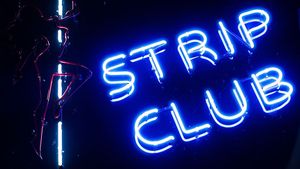Strip club: Difference between revisions
m (Text replacement - "Portal:Sex industry" to "Sa-sex industry") |
m (Text replacement - "{{cat1|" to "{{cat|") |
||
| Line 32: | Line 32: | ||
{{sa-dance|ero}} | {{sa-dance|ero}} | ||
{{Sa-sex industry}} | {{Sa-sex industry}} | ||
{{ | {{cat|Erotic dancers}} | ||
{{footer}} | {{footer}} | ||
Latest revision as of 07:18, 27 June 2022
A strip club is a bar or nightclub that offers strip tease and possibly other related services such as lap dances. High-end establishments tend to call themselves gentlemen's clubs. Low-end establishments may be referred to as titty bars or girly bars. Go-Go bar may imply a greater focus on stage dancing and music. In a bikini bar dancers are restricted to wearing bikinis or lingerie.
Clubs
Men are the primary consumers of this form of entertainment, at straight clubs and gay clubs, but at least one chain, Chippendales, caters mainly to straight women. Since the main attraction of a strip club is the stage show, almost all clubs have a cover charge.
Gentlemen's and strip clubs, are a $5-billion dollar (U.S.) industry, generate approximately 22% of the gross revenue in adult entertainment. Such clubs are also found outside the USA.
Sapphire Gentlemen's Club in Las Vegas has been billed as the world's largest and most expensive strip club; in 2006 it was sold at auction for $80 million. Tampa, Florida is well known for its strip clubs including the famous Mons Venus. Howard Stern makes frequent mention of Scores in New York City. Manila, Bangkok, and Pattaya are world-famous for their Go-Go bars offering a variety of extra services (but no legal strip-tease). Amsterdam is famous for its live sex shows in De Wallen.
Performers
Performers are called strippers, exotic dancers or just dancers, or entertainers. House dancers work for a particular club or franchise. Feature dancers tend to have their own celebrity, touring a club circuit making appearances. Porn stars will often become feature dancers to earn extra income and build their fan base.
Dancers collect tips from customers either while on stage or after the dancer has finished a set and is mingling with the audience. A typical tip is 1 or 2 dollars, folded lengthwise and placed in the dancer's g-string or garter. In countries, without small paper bills (such as Euro nations, Australia and Canada) customers can throw $1 or $2 coins onto the stage. Oftentimes these coins will be placed in the mouth of a male patron and the dancer will take the coin using her private areas.
Dancers may offer additional services such as lap dances or a trip to the champagne room, for a set fee rather than a tip.
In the U.S., striptease dancers are generally classified as independent contractors. While a few smaller strip clubs may pay a weekly wage, for the most part, all of a dancer's income is derived from tips and other fees they collect from customers. In most clubs, dancers have to pay a "stage fee" in order to work a given shift. This fee can range from a few dollars to $100 or more for larger, high-end clubs. In addition, many clubs take a percentage of each sale of private dances. It is customary in the United States for dancers to also pay a "tip out", which is money paid to staff members of clubs like DJs and bouncers, at the end of their shift.
Legal issues
In several regions of the US, primarily due to the local legal restrictions, strip clubs often fall into one of two categories: topless and all/fully nude. Dancers in topless clubs are allowed to expose their breasts, but they are prohibited from exposing their genitals. Topless dancers typically perform in a G-string and depending on local laws, may be required to wear pasties covering their nipples.
Fully nude clubs may be subject to additional requirements such as restrictions on alcohol sales or no-touch rules between customers and dancers. Several states have filed First Amendment lawsuits to get around these rules two "separate" bars -- one topless and one fully nude -- may open adjacent to one another. In a small number of states and jurisdictions, where it is legal for alcohol to be consumed but not for alcohol to be sold, some clubs allow customers to bring their own beverages. These are known as BYOB clubs.
In Barnes v. Glen Theatre, decided in 1991, the Supreme Court of the United States ruled that a state can totally ban topless or nude dancing as Indiana did. A liberal social climate keeps most locales in the USA from doing this though. However, in recent years, many cities, such as New York City, have enacted ordinances prohibiting "adult entertainment" businesses from within a certain distance of houses, schools, and churches. Often, a distance of nearly half a mile is stipulated, thus guaranteeing that no new strip clubs can be opened in many major cities. Courts have generally upheld these zoning laws.
Touching of strippers is illegal in most states. However, some dancers and some clubs condone the touching of dancers during private dances. This touching often includes the fondling of breasts, buttocks, and in rare cases the vaginal region. In some locales, dancers may give a customer a "friction dance", whereby the dancer grinds against the customer's crotch while he is fully clothed in an attempt to arouse him or bring him to climax.
| Articles related to: Dance and/or Competitive dance |
|---|
|
|
Chat rooms • What links here • Copyright info • Contact information • Category:Root
